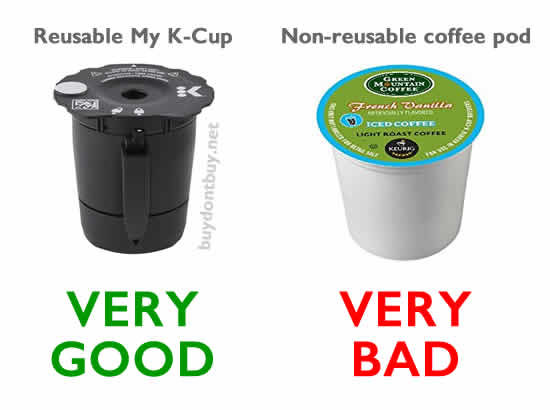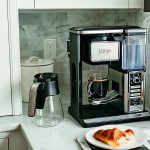Green Mountain Coffee Roasters of Waitsfield, Vermont
Green Mountain Coffee Roasters was once a tiny little specialty coffee shop in tiny little Waitsfield, Vermont. Gourmet coffee wasn’t really a “thing” in 1981, but an entrepreneur named Bob Stiller wanted it to be. He was such a fan that, after tasting their product at a nearby ski resort, he inquired as to where the beans had come from. He would later wind up buying Green Mountain Coffee Roasters.
What he had bought was just a small town Vermont business at the time, but Stiller hit the streets and eventually dove into mail order, selling coffee to everyone he possibly could. Before long, he had built the reputation of Green Mountain as an eco-friendly supporter of fair-trade coffee. Ten years and 1,000 wholesale supply contracts later, Green Mountain Coffee Roasters was doing $11 million in annual sales.

Keurig Comes Knocking
In 1993, a couple of engineering nerds named John Sylvan and Peter Dragone created a venture capital-funded startup called Keurig. Their mission was to build a single-cup coffee brewer for the home. They chose the name because they thought it was Dutch for “excellence” when, in fact (at least according to Google and Wikipedia), the meaning is closer to “proper” or “neat.” Eh, close enough.

Along with their partner Dick Sweeney, Sylvan and Dragone met up with Bob Stiller to talk about building a single cup coffee maker, and Stiller (of course) bought a stake in the company. Four years later, in 1997, the K-Cup was born. It fit into third party K-Cup-compatible coffee makers by such household names as Cuisinart and Mr. Coffee. A year after that came the first Keurig brewer.

The Birth of a Coffee Juggernaut
The timing of this union between Green Mountain and Keurig couldn’t have been better. It was all happening in the 1990s, a time when new Starbuck’s locations seemed to be popping up about every 10 minutes across America. Meanwhile, Stiller gradually increased his stake in Keurig until he owned the company outright in 2006.
Bob Stiller and Green Mountain Coffee Roasters, now in full control of Keurig and its novel K-Cup coffee delivery format, began transitioning from selling low-margin wholesale coffee to ridiculous-margin single serving coffee. Many estimates peg the per-pound cost of today’s Keurig K-Cups at around $40-$50 per pound. Compare that with Keurig’s own Green Mountain Coffee that they sell for less than $10 per 10 ounce bag, and it’s easy to see why the business model shifted.
With franchise coffee shops and the “gourmet” coffee market continuing to spur the growth of a new coffee culture in America and abroad, Green Mountain’s sales exploded. Their 2007 annual report stated a net income of less than $13 million. By 2013, net income had multiplied 37 times over to more than $483 million. In 2014, Green Mountain’s shareholders voted to change the company name to Keurig Green Mountain, probably to better reflect where all that money was coming from.
Bob Stiller Goes Nuts
As the founder of Green Mountain, Bob Stiller owned millions of shares in the newly-named company. In 2011, Stiller was declared a billionaire by Forbes. He was worth over $1 billion … on paper, that is. That didn’t stop him from buying the kind of party yacht you only see in rap videos, a mansion in Florida, and Tom Brady’s $17 million Manhattan condo. Stiller was used to being rich thanks to previous entrepreneurial pursuits, but he wasn’t used to being a billionaire (again, on paper only) and it showed.
Bob Stiller was spending truckloads of money he didn’t actually have. And unlike the impeccable timing of his investment in Keurig during the 1990s coffee boom, his timing in this case couldn’t have been worse. As Stiller aggressively pursued the lavish lifestyle of a billionaire, short sellers on Wall Street aggressively drove down the stock price of Keurig Green Mountain.
Stiller’s lenders, in turn, had a collective panic attack and forced him to sell his Green Mountain shares. The stock price was already reeling thanks to the short sellers, and Stiller’s unloading of such a huge volume of shares was a violation of Keurig Green Mountain’s rules. Whenever a company executive dumps shares en masse, Wall Street takes that as a sign of trouble. Stiller’s stock dump proved to be damaging to the company and, the next thing he knew, the board of directors had kicked him out of the company he started.
The company’s stock price eventually recovered and hit an all-time high of $177 per share in late 2014, but of course Stiller wasn’t invited back. Keurig Green Mountain would continue to maintain the environmentally friendly, grassroots posture of the early incarnation of Stiller’s Green Mountain Coffee Roasters, but there is still some debate over whether or not the company’s values departed with him.

K-Cups Around the World, Literally
Although Keurig invented the K-Cup in 1997, public outcry over the environmental consequences of their difficult-to-recycle construction didn’t really gain steam until about 2010. It was then that the Boston Globe published a fairly incriminating article about the K-Cup’s environmental impact.
Keurig Green Mountain was in the habit of publishing K-Cup sales figures in their annual report up until 2009, but that stopped abruptly after the Boston Globe outed their K-Cups as being horrible for the environment. Since then, Keurig Green Mountain’s annual reports have done away with the graph of “K-Cup Portion Packs Shipped.” These days, they refer only to the percentage of growth in K-Cup net sales.

Back in 2009, Keurig’s last public report of K-Cup sales showed that over 1.6 billion “portion packs” had been shipped. More recently, The Atlantic’s John Hamblin, in his now-infamous interview with K-Cup inventor and Keurig co-founder John Sylvan, said that Keurig admitted they had sold over 9 billion K-Cups in 2014. It is widely estimated that enough K-Cups were dumped in landfills in 2014 to circle the globe 10.5 times.
Hamblin points to more accurate estimates that say the number is over 12 circumnavigations. Sylvan, who was apparently ousted from the company and handed a paltry $50,000 for his troubles, even told The Atlantic that he regrets ever inventing the things because they’re so bad for the planet.
The Keurig 2.0 Cash Grab
Keurig Green Mountain held the patent for K-Cups until 2012. On the heels of that patent expiration, a bunch of enterprising coffee producers started to sell their own Keurig-compatible cups. This was, no doubt, great for Keurig in terms of increasing the popularity of their Keurig coffee brewers, but it put a big dent in Keurig-made K-Cup coffee sales.
Keurig tried to remedy this situation with the release of the Keurig 2.0 brewer in 2015. With the help of third-party pod coffee makers, they had already become a household name, so it was time to kick the unlicensed pod coffee brands to the curb. In doing so, Keurig would claim an even bigger share of the pod coffee market they had created. In board game terms, they would have owned pretty much everything, except for maybe Baltic and Mediterranean Avenues. It seemed like the perfect plan.
The Keurig 2.0 brewer, you see, was designed to brew coffee with real, licensed K-Cups only. No imitators allowed. A little scanner inside the machine looked for a special type of ink on the cup’s lid, and if the ink wasn’t there, the machine gave a glib little “OOPS!” message and refused to make your coffee.

Naturally, owners of Keurig brewers were furious. These were people who had found their favorite, and often cheaper, coffee blends in a variety of pod coffee manufacturers, including non-Keurig brands. Some were also attempting to save money (and the planet) with a reusable K-Cup replacement called My K-Cup.
Keurig’s My K-Cup is a reusable pod that allows Keurig owners to fill it with the coffee of their choice at standard per-pound coffee prices rather than the deceptively priced single serving pods Keurig was known for. The Keurig 2.0 was built to take away these choices and literally force Keurig owners to buy Keurig’s then-non-recyclable K-Cups and no one else’s.
To make matters even worse, Keurig also announced that not only would they be discontinuing the reusable My K-Cup, but existing My K-Cups would not work with the Keurig 2.0. With this blatant and shameless move to pad the corporate bottom line, all Keurig owners would have to resume spending an estimated $50 per pound of K-Cup coffee.
With public outrage surging and brewer sales plummeting, Keurig magically realized the error of their ways, and by error I mean evil. They had tried to take away consumer choice. They had tried to pull off a money-grab of epic proportions, but it turned into a gigantic blunder that would besmirch the company’s reputation. In response to the backlash, Keurig brought the My K-Cup back, which more or less defeated the purpose of the Keurig 2.0.
The Infamous Keurig Kold
2015 would see another major goof by Keurig: the very short-lived Keurig Kold. The Keurig Kold was meant to do for soft drinks what Keurig coffee makers did for coffee. Consumers would buy pods manufactured by major soft drink companies, and the Keurig Kold would turn those pods into a fizzy glass of Coke or Dr. Pepper or whatever kind of pod you stuck into it.
The only problem was that the Keurig Kold was a total piece of garbage. It was loud, slow, and just generally annoying. Oh, and this wonderful machine also cost $350. And much like the inflated cost of Keurig’s pod coffee, pod soft drinks were stupidly expensive. Keurig discontinued the Keurig Kold just one year after it was released, but at least they were nice enough to offer full refunds to all the suckers, I mean consumers, who had bought it.
 I made this Keurig Kold gravestone to announce Keurig’s refund program.
I made this Keurig Kold gravestone to announce Keurig’s refund program.
Present Day
Since Keurig’s embarrassingly bad 2015, they have taken the positive step of making their coffee pods recyclable. More recently, they also acquired Dr. Pepper Snapple Group for a cool $18.7 billion in cash. So now Keurig Green Mountain has a new name, Keurig Dr. Pepper. Hopefully that doesn’t mean any nasty surprises for consumers, but with Keurig, I guess you never know.
Conclusion
If you’re a Keurig user, there’s really only one thing that you absolutely must take away from this article: Use a Keurig My K-Cup, or one of the many imitators that does the exact same thing. Keurig’s K-Cups may be recyclable, but they’re not reusable. Literally tons of them are still winding up in landfills around the world, but that doesn’t have to be the case. Filling your own My K-Cup will save you money, and you’d also be doing our poor little planet a favor.
There are other things to be learned from Keurig’s story as well. Be bold! Be innovative! Don’t spend billions of dollars you don’t have! And more than anything, use your voice as a consumer. People who review products on Amazon are the real heroes. Without them, and the columnists who wrote volumes about the evil Keurig 2.0, Keurig might still be forcing the world to buy their K-cups and nobody else’s.
Consumers have enormous strength in numbers, and Keurig’s recent history is a testament to that. If there’s something you hate … or also, something you love … get on Amazon and write that review! An increasing number of corporations are monitoring those reviews. They’re mostly just looking for fires to put out (and they might also reach out to you if you complain), but they’re no doubt taking that feedback into board meetings as well.

[insert_php]
include ‘amazon_related_products_coffee.php’;
[/insert_php]





